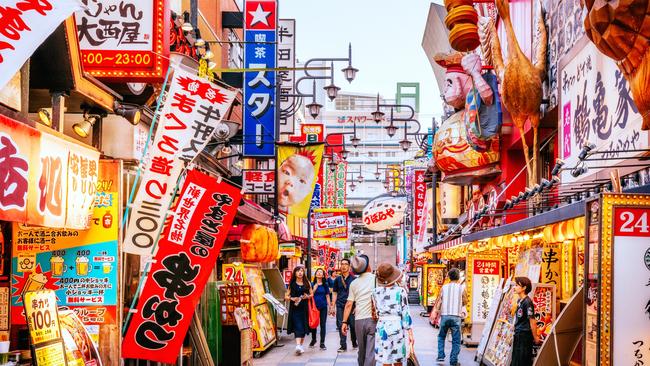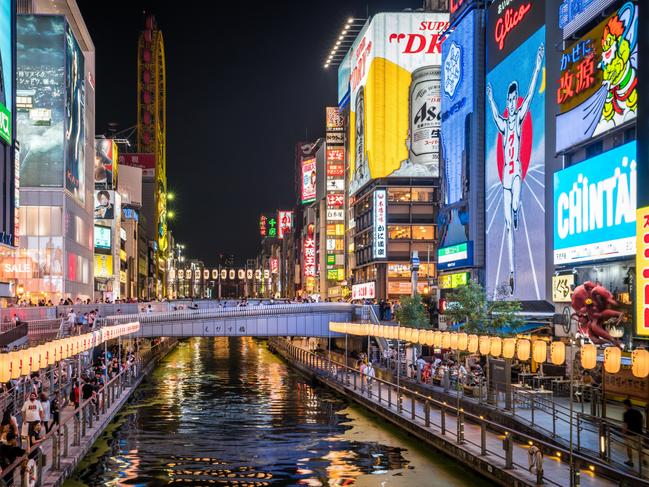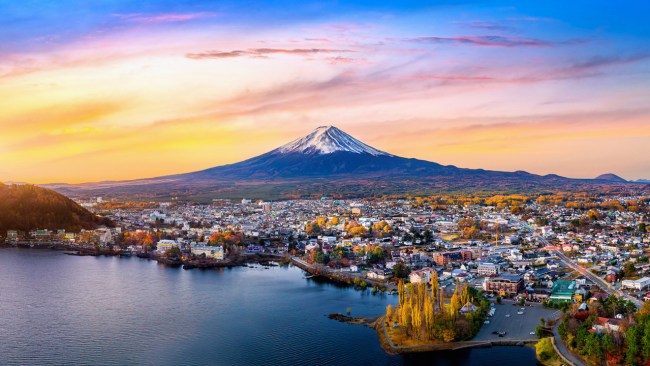Cheat Sheet: 6 things every traveller needs to know in Osaka
It may be smaller than the capital, but this city rivals Tokyo for its tourist drawcards — and if you don’t do this, you’re not doing it right.

Lifestyle
Don't miss out on the headlines from Lifestyle. Followed categories will be added to My News.
Japan’s third largest city in size, but second in population, rivals Tokyo in impact; it’s loud, gritty, somewhat hyperactive and totally in your face. Locals are notably more casual in attitude and dress-sense than big sister Tokyo – quick to crack a joke, utterly obsessive about their brand of cuisine and serious shoppers. Osaka offers incredible entertainment for kids of all ages and easy access to traditional Kyoto and Nara. If you don’t sip, sup and spend your way around this zealous city you haven’t done it right!
SHOW ME THE WAY
Mid-January to May (avoiding Golden Week holidays) and late September to end of December are the most comfortable times to travel. Osaka, three hours southwest of Tokyo by bullet train, has two international airports – Kansai International Airport (KIX) and Itami (ITM, catering to domestic airlines only). Qantas and Jetstar fly direct from Australia to KIX – a man-made island attached to the mainland via an impressively protracted bridge.
Get downtown fast via Nankai Rapi:t express train (35 minutes and about ¥1094 (about $15) for adults/$8 for kids) to Nanba station. Taxis are about $200 for the hour’s drive but the airport limousine bus, stopping at several locations, is just $20. Itami airport, closer to Osaka city, is a 50-minute monorail/train combo downtown, a 35-minute bus ride or a 30-minute cab-ride. MK Taxi offers a set price private transfer from Itami to Osaka for $90 (regular cab $115).
NEVER DO THIS IN A JAPANESE TAXI
25 THINGS YOU NEED TO KNOW ABOUT JAPAN
WHY I FELT CHEATED AFTER VISITING JAPAN

TRAIN-EASE IF YOU PLEASE
Several major train stations run north (kita) to south (minami) through central Osaka city flanked by “subcities” of accommodation, shops and eateries. The Osaka Loop line (Kanjosen) whips you around the city in both directions. Although the local subway system can feel hairy for sheer commuter numbers, getting cosy with the Midosuji line, running north to south, makes life sweet for connecting across town and between Umeda and Namba.
PLAY YOUR CARDS RIGHT
ICOCA has long been Kansai’s (Osaka, Kobe, Kyoto area) travel card for ground transport, however, recently Tokyo’s Pasmo and Suica cards have become usable around Japan and vice versa for ICOCA.
Osaka Metro one-day passes offer unlimited subway and city-bus travel with some sightseeing discounts ($8 weekdays, $10 weekends and holidays, $4 for kids) but, if you’re on a mission, check out the $45pp, two-day Osaka Amazing Pass featuring the same unlimited travel and more than 35 free hot spots and activities plus various discounts including at theatres and restaurants.

NEIGHBOURHOOD LOWDOWN
North: Umeda is an upscale business district supported by equally fancy shopping and entertainment complexes. Between Grand Front, a fashionable shopping, gourmet and lifestyle venue and Osaka Station’s North Gate Building, you’ll find the brilliant Gurunavi TIC, offering free assistance accessing Umeda’s best eats. Head to Umeda Sky Building’s rooftop observatory for spectacular sunsets and nightskies.
Chayamachi’s funky laneways are great to wander for boutiques and dining spots while hip Nakazakicho, a 10-minute walk east, is where the cool kids meet for coffee, gallery hopping and handmade design wares.
South: Shinsaibashi is unabashedly animated. Under 25, or geared with earplugs and reflective eyeware? You’re set to strut the 1800s-built – yet overtly sparkly – Shinsaibashi-suji shopping arcade. Dotonbori’s OTT entertainment strip is strewn with overhead giant foods, from crabs to gyoza (dumplings) advertising cheap eats and famed for takoyaki – golden, molten batter balls studded with octopus and pickled ginger.
Hot tip: head to Abeno Takoyaki Namachan in Nanba. Another must try is okonomiyaki, a savoury pancake/fritter topped with special sauce and mayonnaise.
A neon-backdropped selfie on the Ebisu Bridge officially stamps your “Osakan passport”.
Hozenji Yokocho, a stone-paved alley lined with tiny restaurants selling an excellent variety of fresh seafood is particularly charming under lantern light.
America-mura will appeal to vintage and vinyl enthusiasts or 20-somethings wishing to “hang”.
Horie, an adjacent pocket, offers cute cafes and local fashions.

A bit further south: Namba Station area is where you’ll find Nankai tourist information centre and sprawling shopping complexes, such as Namba Parks, terraced with living green spaces, and Namba SkyO for crafted goods and cultural workshops.
Slightly northeast is Sennichimae Dogayasuji Shotengai (Kitchenware street) and Kuromon Ichiba, a terrific, old-fashioned food market – absolute musts for keen cooks.
Southeast: Den Den electric town is tech and gaming paradise. Nearby Tennoji is rough and ready in parts but revered for old-school izakaya shacks around the 1950s Tsutenkaku tower, featuring kushikatsu (deep-fried crumbed morsels on skewers). Shitennoji flea market, held monthly on the 21st & 22nd, sells vintage textiles and antiques. Nearby Korea town offers K-pop, yakiniku (grilled beef or pork) and kimchi gold.
East: Head inland for historic Osaka Castle’s impressive grounds.
West: Head to the coast and Osaka Bay area for Universal Studios and the Kaiyukan Osaka aquarium.

WHERE SHOULD I STAY?
As you’ll mostly spend time around Umeda and Namba select accommodation close to either station for accessing all areas.
OSAKA SPEAK
Learning a little Kansai-ben, a Japanese dialect also understood in Kyoto and Kobe, will put you in good favour with the locals. Kuidaore (kwee-dah-oray) means “to eat oneself bankrupt” and that sums up Osaka’s attitude towards good food. Ookini (aww-kinney) means “thank you”; Nambo means “how much?”; Metcha (met-cha) means “very” – for example, metcha atsui: it’s very hot.
Stuck for words? Dial the free Osaka Call Center for tourism and medical assistance.
Originally published as Cheat Sheet: 6 things every traveller needs to know in Osaka



